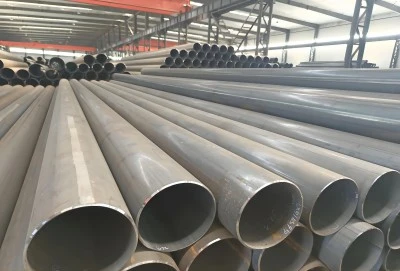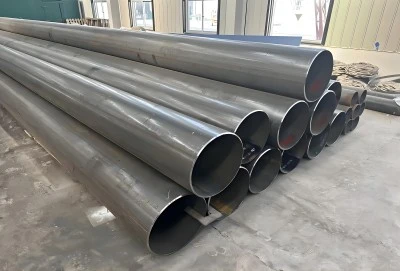Long seam welded pipes are essential components in various industries, including oil and gas, construction, and infrastructure development. These pipes are manufactured using different welding techniques to ensure their strength, durability, and reliability.
|
|
|
What are the Main Welding Processes Used in Long Seam Welded Pipe Production?
The production of long seam welded pipes involves several welding processes, each with its own advantages and applications. The choice of welding technique depends on factors such as pipe diameter, wall thickness, material properties, and intended use.
- Submerged Arc Welding (SAW): This method is widely used for producing large-diameter, thick-walled pipes. SAW offers high welding speeds and excellent weld quality, making it ideal for demanding applications.
- Electric Resistance Welding (ERW): ERW is commonly employed for smaller diameter pipes and tubes. It's known for its efficiency and cost-effectiveness in high-volume production.
- Longitudinal Submerged Arc Welding (LSAW): A variation of SAW, LSAW is specifically used for creating long seam welds in large-diameter pipes.
- High-Frequency Welding (HFW): This process is often used for smaller diameter pipes and offers high production speeds.
While all these methods play crucial roles in pipe manufacturing, we'll focus on SAW and ERW due to their widespread use and significant impact on long seam welded pipe quality.
How Does Submerged Arc Welding (SAW) Enhance Long Seam Welded Pipe Quality?
Submerged arc welding is a cornerstone technique in the production of high-quality long seam welded pipes, particularly for large-diameter and thick-walled applications. This method offers several advantages that contribute to enhanced pipe quality:
1. Superior Weld Quality: SAW produces deep penetration welds with excellent fusion between the pipe material and the weld metal. This results in a strong, uniform seam that can withstand high pressures and stresses.
2. High Deposition Rates: The SAW process allows for high welding speeds and deposition rates, making it efficient for large-scale pipe production. This increased productivity doesn't come at the cost of quality, as the submerged arc ensures consistent weld properties.
3. Minimal Weld Defects: The flux used in SAW protects the weld pool from atmospheric contamination, reducing the likelihood of porosity, inclusions, and other weld defects. This protection contributes to the overall integrity of the welded seam.
4. Versatility in Material Thickness: SAW can effectively weld a wide range of material thicknesses, from moderate to very thick pipes. This versatility makes it suitable for various pipe specifications and applications.
5. Excellent Mechanical Properties: The welds produced by SAW typically exhibit high tensile strength, good impact toughness, and favorable fatigue resistance. These properties are crucial for pipes that may be subjected to severe operating conditions.
The effectiveness of SAW in enhancing long seam welded pipe quality is evidenced by its widespread use in critical applications such as oil and gas pipelines, where reliability and safety are paramount.
What Role Does Electric Resistance Welding (ERW) Play in Manufacturing Long Seam Welded Pipes?
Electric Resistance Welding (ERW) is another vital technique in the production of long seam welded pipes, particularly for smaller diameter pipes and high-volume manufacturing. ERW offers unique advantages that make it indispensable in certain applications:
1. High Production Speeds: ERW is known for its rapid welding speeds, making it ideal for mass production of smaller diameter pipes. This efficiency translates to cost-effectiveness in manufacturing.
2. Consistent Weld Quality: The ERW process uses precisely controlled electrical current and pressure to create welds, resulting in highly consistent seam quality along the entire length of the pipe.
3. Suitable for Thin-Walled Pipes: ERW is particularly effective for welding thin-walled pipes, where other methods might risk burn-through or distortion. This makes it a preferred choice for applications requiring lighter-weight pipes.
4. Energy Efficiency: Compared to some other welding methods, ERW is relatively energy-efficient, as heat is generated directly at the weld interface without the need for external heat sources.
5. Clean Welds: ERW produces clean welds with minimal spatter or excess material, often eliminating the need for post-weld cleanup or machining.
6. Versatility in Materials: While commonly used for carbon steel pipes, ERW can also be applied to various other materials, including stainless steel and some non-ferrous metals, broadening its applicability in pipe manufacturing.
The role of ERW in long seam welded pipe production is particularly significant in industries requiring high-volume production of smaller diameter pipes, such as in the construction sector, water distribution systems, and certain oil and gas applications.
Contact LONGMA GROUP
The quality and performance of long seam pipes are heavily dependent on the welding techniques used in their production. Submerged Arc Welding (SAW) and Electric Resistance Welding (ERW) stand out as two of the most crucial methods, each offering unique advantages in different applications.
SAW excels in producing high-quality welds for large-diameter, thick-walled pipes, making it indispensable in critical applications like oil and gas pipelines. On the other hand, ERW shines in the high-volume production of smaller diameter pipes, offering efficiency and consistency that are vital in many industrial and construction applications.
Understanding these welding techniques is essential for engineers, project managers, and procurement specialists involved in projects requiring long-seam welded pipes. The choice between SAW, ERW, or other welding methods can significantly impact the performance, reliability, and cost-effectiveness of the final product.
At LONGMA GROUP, we specialize in producing top-tier long seam welded pipes using advanced welding technologies, including SAW and ERW. Our commitment to quality and adherence to international standards ensures that our pipes meet the most demanding requirements across various industries.
Are you looking for high-quality long-seam pipes for your next project? Whether you need large-diameter SAW pipes for a major pipeline or efficient ERW pipes for a construction project, LONGMA GROUP has the expertise and capabilities to meet your needs. Contact us today at info@longma-group.com to discuss your specific requirements and discover how our advanced welding techniques can contribute to the success of your project.














